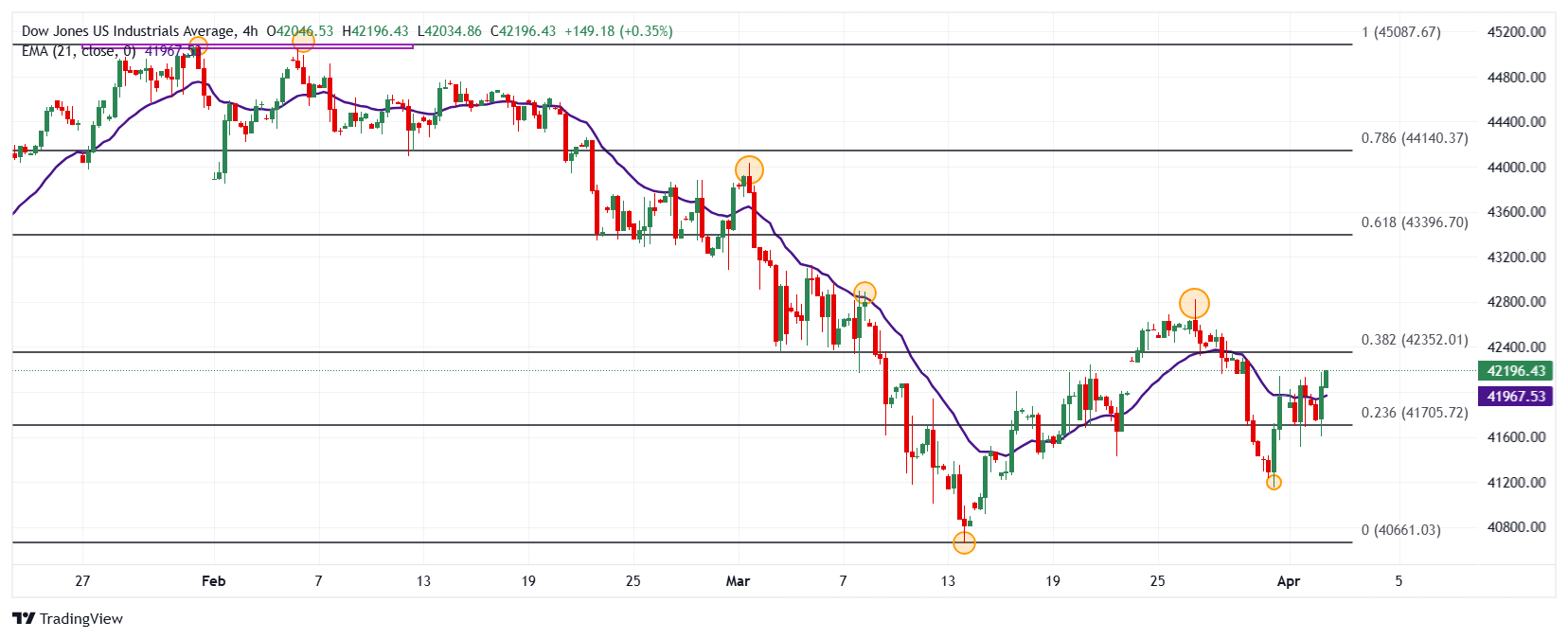- The Dow Jones rises 0.39% in the day, reaching maximums of March 28.
- The Nasdaq 100 wins 0.81% daily, driven by Tesla (Tslar) and Dordash (Dash).
- The S&P 500 rebounds 0.79% on Wednesday, signing three consecutive upward sessions.
- The ADP employment report registered 155 new positions in March, improving market forecasts.
- The attention of investors will be placed in the announcement of reciprocal tariffs by Donald Trump, at the close of the market.
The Dow Jones marked a minimum of the day in 41,608, attracting buyers who promoted the index to a maximum not seen from March 28 in 42,174.
The industrial average Dow Jones opened in 41,934, while the Nasdaq 100 technological index began negotiations in 19,411. The S&P 500 began operating in 5,607, spinning three consecutive days with profits.
Goldman Sachs and Amazon lead the profits at Dow Jones
The Dow Jones index wins 0.39% daily, currently operating over 42,135, reaching three -day maximums in 42,174.
The titles of the Goldman Sachs Investment Bank (GS) have a gain of 2.15% today, reaching maximum of March 27 in 562.57 $.
Following the bullish perspective, Amazon shares (AMZN) rise 1.05% in the day, signing three consecutive upward sessions, reaching maximum of three sessions in 195.15 $.
The Dow Jones remains in positive field, consolidating within the operational range of the previous session, waiting for Donald Trump’s statements in relation to the imposition of reciprocal tariffs.
The Nasdaq 100 is quoted on positive terrain driven by Tesla and Dordash
The Nasdaq 100 technological index rebounds 0.81% today, reaching maximums of March 28 in 19,596.
The actions of Dordash (Dash) earn 4.06% on Wednesday, visiting three -day maximums in 190.51 $.
In the same tuning, Tesla titles (TSLA) extend their profits and shoot 5.55% in the day, reaching March 27 at 283.52 $, signing its second consecutive day with profits.
In this context, the Nasdaq 100 leads the profits in the main share rates, operating the time of writing about 19,592, spinning three consecutive upward sessions.
The S&P 500 reaches maximum three days prior to Donald Trump’s tariff announcement
Based on the most recent Employment Report of Automatic Data Processing (ADP), 155,000 new positions were recorded in March, above the expected 105,000 and 84,000 observed in February.
The securities of Read Holdings (LDOS) lead the profits in the S&P 500, rebuking 5.56% daily, reaching maximums not seen since March 10 in 142.68 $.
The S&P 500 stock index rises 0.79% today, signing its third consecutive day with profits reaching three days in 5,663.
The Center for Care will be placed in the tariff imposition of the administration led by Donald Trump, at the close of the market.
Technical Analysis of Dow Jones
The Dow Jones is in a lateral range between the maximum of March 26 in 42,820 and the minimum of March 31 in 41,153, waiting for the next directional movement. The next key resistance is observed in 44,033, maximum of March 3. Downwards, the following important support is located in 40,660, pivot point of March 13.
4 -hour graph of Dow Jones

Dow Jones Faqs
The Dow Jones Industrial Avenge, one of the oldest stock market indexes in the world, consists of the 30 most negotiated values in the United States. The index is weighted by the price instead of capitalization. It is calculated by adding the prices of the values that compose it and dividing them by a factor, currently 0.152. The index was founded by Charles Dow, also founder of the Wall Street Journal. In recent years it has been criticized for not being sufficiently representative, since it only follows 30 companies, unlike broader rates such as S&P 500.
There are many factors that promote the Dow Jones Industrial Average (DJIA) index. The main one is the added performance of the companies that compose it, revealed in the quarterly reports of business benefits. The American and world macroeconomic data also contribute, since they influence investor confidence. The level of interest rates, set by the Federal Reserve (FED), also influences the DJia, since it affects the cost of credit, on which many companies depend largely. Therefore, inflation can be a determining factor, as well as other parameters that influence the decisions of the Federal Reserve.
Dow’s theory is a method to identify the main trend of the stock market developed by Charles Dow. A key step is to compare the direction of the Dow Jones Industrial Avenge (DJIA) and the Dow Jones Transportation Average (DJTA) and just follow the trends in which both move in the same direction. The volume is a confirmation criterion. The theory uses elements of maximum and minimum analysis. Dow’s theory raises three phases of the trend: accumulation, when intelligent money begins to buy or sell; Public participation, when the general public joins the trend; and distribution, when intelligent money abandons the trend.
There are several ways to operate with the DJ. One of them is to use ETF that allow investors to negotiate the DJ as a single value, instead of having to buy shares of the 30 companies that compose it. An outstanding example is the SPDR Dow Jones Industrial Avenge ETF (day). Future contracts on the DJ allow the specular operators about the future value of the index and the options provide the right, but not the obligation, to buy or sell the index at a predetermined price in the future. Investment funds allow investors to buy a part of a diversified portfolio of DJ values, which provides exposure to global index.
Source: Fx Street
I am Joshua Winder, a senior-level journalist and editor at World Stock Market. I specialize in covering news related to the stock market and economic trends. With more than 8 years of experience in this field, I have become an expert in financial reporting.


.jpg)




